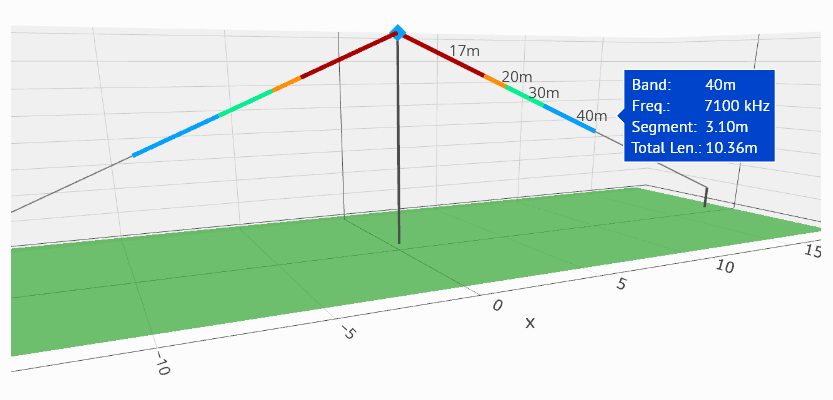portable antennas
Welcome to portable-antennas.com! This site aims to provide the radio amateur with easy-to use tools enabling design and modelling of simple wire antennas for the HF bands, primarily for amateur radio portable use, such as for activations of parks, hills and mountains, islands and lighthouses in the various amateur radio outdoor award schemes. Like all such antennas, they can also be used at a home QTH.
The tools included in each designer page enable displays of radiation patterns, VSWR curves, antenna current diagrams, and Smith charts - all calculated and displayed dynamically for the antenna you design. No other website offers such an extensive set of tools to check your antenna design.

Example azimuth radiation pattern
|

Example elevation radiation pattern
|
Power to the user
The designer pages in this site use the powerful industry-standard NEC engine * in the background to dynamically calculate data describing the performance of the antenna you have designed. These data are then parsed, analyzed and displayed in the formats you have chosen.
* Currently, a NEC2 engine is used - work is in progress to upgrade this to a NEC4.2 engine.
Of course, other antenna modelling and design tools and programs do exist: for instance: EZNEC Pro, 4Nec2, MMANA-GAL * and others, but all of them need to be installed on your PC or Mac/Linux machine. These programs are certainly very powerful, and generally give very good results - the downside is that such programs are often very complex, and involve a steep learning curve in order to become proficient in even the simplest of tasks. Not everyone has the desire to spend so much time and effort in gaining the skills and knowledge required by such programs to model even the simplest kind of antenna.
* We accept no liability for the content of external links - use them at your discretion.
Easy to use
The tools provided in this site take much of the complexity out from the task of modelling and designing of simple wire antennas. Parameters such as frequency, wire lengths and angles are easily input, and results presented in interactive 3D graphical form at the click of a button.
This is achieved by having each of the designer pages in this site focus on one particular type of antenna, with custom code and options to match, making it much easier for the user to concentrate just on the antenna of their choice. This is quite unlike the approach taken by the programs mentioned earlier because, since they are designed to cater for any and all conceivable antenna types, the large number and scope of options they need to include can quickly become confusing or bewildering.

Experiment!
Users of the antenna designer pages in this site are encouraged to experiment with the antenna designer of their choice, to try different values of frequency, antenna section lengths or angles, height of antenna above the ground, to try out different ground types, and so on. Spend some time to see what effects these changes will have on the antenna's radiation patterns, or on the VSWR, or how currents are distributed in the antenna, as the changes are made. In this way, you will learn a great deal more about your choice of antenna in particular, and also about antennas in general, than just trying one set of values.
Different antenna types
Currently, the following antenna types for the HF bands can be modelled, with more being considered for inclusion:
- Linked dipole antennas - for single or multiple HF bands;
- Off-center-fed dipole (OCFD) antennas - capable of giving good results (low VSWR) on several bands above the principal band;
- End-fed half-wave (EFHW) antennas - capable of giving good results (low VSWR) on several bands above the principal band;
- Vertical antennas - for one single band, with all-round, low-angle radiation - currently in BETA version ;
- Delta loop antennas - for one single band, providing vertically-polarized emissions at low elevation angles - a good DX antenna.
- Half-square antennas - can be configured either as a full-wave single-bander, or as an EFHW multi-bander.
- Moxon antennas - for one single-band, a compact two-element beam antenna with good gain and very good F/B ratio.
Radiation patterns, VSWR charts, antenna currents diagrams and Smith charts
For each of the antenna types currently supported, any combinations of the following charts and diagrams can be generated and displayed:
- azimuth and elevation radiation patterns;
- 3D radiation patterns;
- NEW azimuthal horizontal and vertical polarization patterns;
-
VSWR curves, incorporating real and imaginary impedance curves - VSWR curves are displayed for
either one single band, or over several bands; - antenna currents diagrams, showing how currents are distributed in the antenna;
- Smith charts, showing how antenna reactance changes with frequency.

Export results
Results from the design and modelling can be exported in either PDF, CSV or simple text formats. In addition, antenna dimensions suitable for importing into a professional program can also be exported.
Extras
In addition to the designers, the site also offers the
- Extras page - featuring data-sets and charts for various coaxial cable types, reference correction factors, and calculators
Footnote
Please be aware that this site is a work in progress. From time to time, some functions may not appear to work, or may not work
correctly. This simply means that those functions are in the process of being updated or changed. If it doesn't work now,
check back later!
If any problems with the site should persist,
please use the Contact form to let us know!